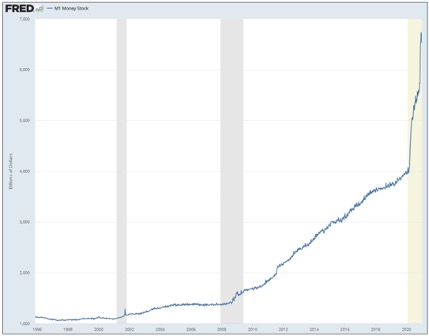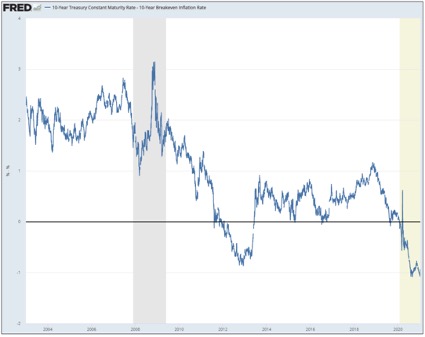Inflation Expectations are Materializing in the Bond Market
The U.S. money supply is divided into three categories — M1, M2, and M3 — with each category progressively less “liquid” in terms of how quickly it can be accessed and spent.
The M1 category includes physical cash and coins, demand deposit bank accounts (the type from which cash can be withdrawn any time), and other liquid forms of money like travelers’ checks and negotiable order of withdrawal (NOW) accounts.
If you want the most elegant case for why inflation is a risk in 2021, it might just be the trajectory of M1 over the course of the past year, as shown below via a chart from the Federal Reserve Bank of St. Louis (FRED).

The chart shows M1 dating back to 1996, and tells a story in three acts:
- Prior to the global financial crisis of 2008, the rise in M1 was fairly tame compared to what came next. A pick-up occurred in the early 2000s, but it hardly registered relative to what followed.
- After the 2008 crisis, M1 started to rise aggressively, heading up and to the right for more than a decade, as the Federal Reserve maintained various quantitative easing (QE) programs.
- In 2020, as a result of pandemic-fighting measures both monetary and fiscal, M1 went vertical. Instead of moving up and to the right as before, it seemed to simply move straight up.
The portion of M1 that sits in bank accounts (demand deposits) can be used by the banks to make new loans and can also be spent by consumers.
When lending and spending picks up in line with a vaccine-powered recovery, the thinking is that all of this liquidity will contribute to inflation (prices for goods and services starting to rise).
Last week, the bond market started to take the prospect of inflation seriously. Ten-year inflation expectations are now above 2% for the first time in two-plus years (since late 2018), and the yield on the U.S. 10-year treasury note is above 1% for the first time since March 2020.
In our view, it was no coincidence inflation expectations surged immediately after Democrats won both Senate seats in the Jan. 5 Georgia special election.
As we explained a few days ago, unified legislative control increases the odds of big spending initiatives — and multiple new rounds of fiscal help, including large stimulus checks — getting pushed through.
With the above said, even though inflation expectations and the 10-year nominal yield are both rising, the real yield has gone more negative than ever.
The real yield is the nominal yield minus inflation. So, for example, if you own a bond that pays 1%, and inflation is 2%, you come out with a loss because inflation eats up your gains. And if inflation expectations are rising faster than interest rates, negative real yields can become even more negative.
That is exactly what we are seeing, as the FRED chart shows below. The black line is the zero level where the real yield (the nominal yield minus inflation expectations) turns negative.

Even with nominal interest rates rising now, the real yield on the 10-year has not been this negative in decades (because inflation expectations are rising faster).
From a Federal Reserve perspective, negative real yields are a feature and not a bug. That is because, when real yields are negative, it means the debt burden is being inflated away. This is a helpful thing when government debt levels are set to explode.
The interesting question is what happens next.
Interest rates can theoretically rise as long as inflation expectations rise faster, with inflation continuing to erode the debt burden. But if interest rates rise too far, too fast, it could mean trouble for stock market valuations (which are supported by low interest rates), or even threaten the economic recovery.
The Federal Reserve will have to pull off an extra tricky balancing act moving forward.
On the one hand, the Fed will want inflation to run a little bit hot (above 2%) as the U.S. economy recovers, and a modest rise in long-term interest rates can comfortably go along with that.
But if inflation starts to get too hot, or interest rates start to spike as investors flee the bond market, the Fed could be forced to take new emergency actions. The four-way interplay here — between interest rates, inflation expectations, stock market sentiment, and the recovery outlook — will be important to watch in the year ahead.